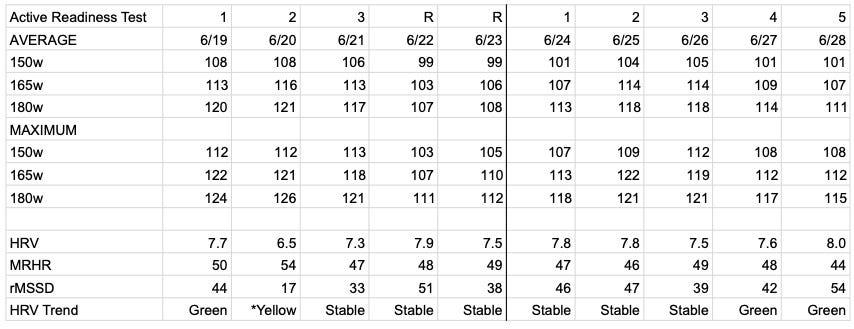Dynamic Loading via Daily Readiness Assessments
Quite a mouthful, that title.
Put simply, I have been adjusting my daily plan based on my morning metrics.
This article will explain those metrics => overnight, morning and active.
For a guy, who used to plan his workouts 7-10 days in advance and his season 13-20 weeks in advance... this is a radical change!
Lots of lingo in this article - Marco's articles are a big help.
OVERNIGHT via Oura Ring
The overnight assessment is the easiest. I keep my Oura ring charged and download first thing. The ring was helpful getting my health back on track at the end of 2021.
However, for making the decision if I'm ready to absorb load, the overnight reading is not as accurate as my morning test.
I don't recommend the ring to you. I think you'll get more useful information using the next two options.
MORNING via Polar H10 Strap and HRV4Training App
My morning ritual:
Wake up (no alarm)
Head downstairs
Drain bladder
Relax on my couch (supine) with my pulse oximeter going
Take reading via HR strap to HRV4Training app.
The whole process takes ~5 minutes.
If you pay for the PRO level (HRV app), then normal ranges are calculated and shown with baseline (below).
Overnight and Morning are passive metrics - I'm either asleep or lying down. There are good reasons for passive assessments (see Marco's articles linked at the end).
My advice, start collecting the morning metrics and learn your healthy baseline.
These baseline metrics were a big part of my being able to return to training relatively quickly after catching COVID (link is my day by day return diary).
My active readiness test is based on an Olympic Champion's warm-up routine.

SWEDISH ACTIVE READINESS TEST (SART)
I have been working with an Olympic Coach, Johan Röjler. Johan had the idea for me to perform a daily assessment based on NVDP's warm-up.
My bike numbers are FAR below Nils' level. However, the principles are the same.
Six minute steps
Start at 50% of "fit" Threshold watts
End at 65% of "fit" Threshold watts
Nils did his Threshold at 400 watts. At 53, I picked 300w.
The key isn't the Threshold number.
What's important is getting a 50%/65% number that is NOT demanding. You want to have a test you can get through at every level of fitness and fatigue.
I'm using 3 steps (150w/165w/180w). Power via Favero Assioma Duos and total test takes ~20 minutes. Johan is testing himself with a run-based protocol.
We are looking for heart rate suppression and "jumpiness."
Day One of the training cycle - we expect HR to be responsive and jumpy following the 2 off days
Across the micro cycle - we expect some HR suppression BUT when there is material suppression, combined with other factors (mood, HRV, MRHR, soreness, energy) we gauge the risk/benefit for loading
The chart shows two cycles - one where I pulled the plug after three days, and the other where I pushed through fatigue (D2 & D4) and finished strong.
The SART is a nice warm up. My total output is 200 kj and no matter how wrecked I am (see June 22 & 23 above) - the test is doable.
With Passive Metrics (HRV, MRHR), the Red & Strong Green days are obvious.
What's less clear is the signal for the Yellow and Weak Green days. Yellow and Weak Green days are where I make most of my mistakes.
Our hypothesis is fatigue (not-readiness) will manifest via heart rate suppression at submax levels.
By learning my normal response to training, I can decide if I'm in a "better to rest" or "train through" situation. The idea being to back off when my body isn't in a position to absorb more load.
My readiness metrics, when combined with my training log, let me see the sessions that most kick my butt.
Are those sessions "worth it"?
Could there be a more effective way of loading?
These are judgement calls and part of the art of loading.
Overall => make mistakes visible, and learn from them.
LINKS
Marco's articles on using HRV and interpreting the data
NVDP's site (his elite warm-up is inside his document)
My public training log (see Metrics tab)






